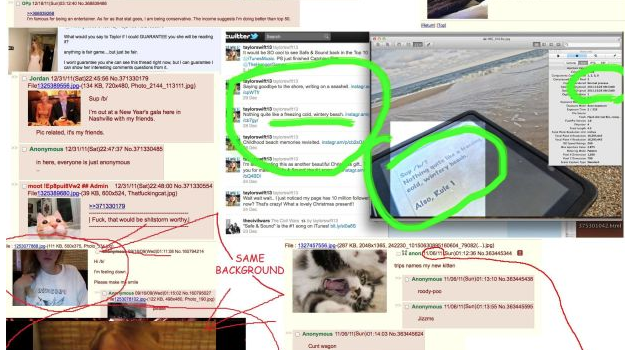Aesthetic Brutal
Aesthetic Brutal

On the internet’s visual language for suggesting — or “confirming” — conspiracy:
There’s a new style of folk art booming on the internet: The crudely rendered, text-and-arrow-happy conspiracy diagram. Let’s call it Chart Brut: Simple, unrefined, urgent, ominous, striving to be informative, and utterly incomprehensible. It’s a digital middle-ground between the string-and-thumbtack cork-board flowcharts favored by premium-cable obsessives like Rust Cohle and Carrie Mathison, and the meaningless tangles of agency responsibilities beloved by security-apparatus bureaucrats, and it’s emerged as the defining folk aesthetic of the 2014 internet. It shows up on message boards and community sites everywhere, attempting to clearly prove and outline connections and conspiracies.
It’s ugly, it’s effective, it’s everywhere, and it’s going to be play a big nasty part in the next election, probably.
I would give these image collages even more credit: In some ways, their popularity anticipated the dominant style of online political discourse in the last couple elections. Their defining feature is their modularity: They require no outside context, they can be emailed or posted or shared in any venue with more or less the same effect. Images travel well! Better than most things online, even still — they worked over email and on forums, and they work even better on social media and Reddit and 4Chan. Daily Show clips and gaffe-recap blog posts functioned similarly in 2012, as comforting moments of closure and comfort; now, identity-focused viral Facebook posts are battling insecurity across the political spectrum.
You don’t even really need to read or watch or examine these types of things! They signal a meaning and imply confirmation, and so they are passed along forever and ever, immune to context or response. They are of a kind with newer but just as annoying passive-aggressive “just one chart” and smug “the perfect reply” posts, which are wielded not to carry out arguments but to end them, but only in the minds of wielders (bowing out of arguments that haven’t actually ended while still somehow feeling victorious is a useful skill for people who love to fight online; these clips and images and posts make it available to everyone.) Chart Brut conspiracy collages accomplish a similar goal by a slightly different route: They end arguments not with certainty but with derailing, vague, unfalsifiable doubt.
